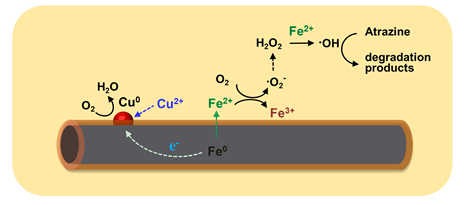| [1] Hayes, T. B.; Collins, A.; Lee, M.; Mendoza, M.; Noriega, N.; Stuart, A. A.; Vonk, A. Proc. Natl. Acad. Sci. U. S. A. 2002, 99, 5476.
[2] Dombek, T.; Dolan, E.; Schultz, J.; Klarup, D. Environ. Pollut. 2001, 111, 21.
[3] Rangsivek, R.; Jekel, M. Water Res. 2005, 39, 4153.
[4] Sun, Y.; Li, J.; Huang, T.; Guan, X. Water Res. 2016, 100, 277.
[5] Liu, N.; Zhao, Y. S.; Zhang, L. Y.; Liu, H.; Liu, P. China Environ. Sci. 2006, 26, 116. (刘娜, 赵勇胜, 张兰英, 刘红, 刘鹏, 中国环境科学, 2006, 26, 116.)
[6] Chen, J. L.; Alabed, S. R.; Ryan, J. A.; Li, Z. J. Hazard. Mater. 2001, 83, 243.
[7] Boussahel, R.; Harik, D.; Mammar, M.; Lamara-Mohamed, S. Desalination 2007, 206, 369.
[8] Kim, G.; Jeong, W.; Choe, S. J. Hazard. Mater. 2008, 155, 502.
[9] Liang, L.; Guan, X.; Shi, Z.; Li, J.; Wu, Y.; Tratnyek, P. G. Environ. Sci. Technol. 2014, 48, 6326.
[10] Cheng, R.; Wang, J. L.; Zhang, W. X. Prog. Chem. 2006, 18, 93. (程荣, 王建龙, 张伟贤, 化学进展, 2006, 18, 93.)
[11] Nagpal, V.; Bokare, A. D.; Chikate, R. C.; Rode, C. V.; Paknikar, K. M. J. Hazard. Mater. 2010, 175, 680.
[12] Xu, X. H.; Wei, J. J.; Wang, D. H. China Environ. Sci. 2004, 24, 76. (徐新华, 卫建军, 汪大翚, 中国环境科学, 2004, 24, 76.)
[13] Zhang, W. X. J. Nanopart. Res. 2003, 5, 323.
[14] Li, Y.; Zhang, Y.; Li, J.; Zheng, X. Environ. Pollut. 2011, 159, 3744.
[15] Ai, Z.; Gao, Z.; Zhang, L.; He, W.; Yin, J. J. Environ. Sci. Technol. 2013, 47, 5344.
[16] Huang, Q.; Cao, M.; Ai, Z.; Zhang, L. Appl. Catal. B-Environ. 2015, 162, 319.
[17] Kettle, A. J.; Anderson, R. F.; Hampton, M. B.; Winterbourn, C. C. Biochemistry 2007, 46, 4888.
[18] Wang, L.; Cao, M.; Ai, Z.; Zhang, L. Environ. Sci. Technol. 2014, 48, 3354.
[19] Mills, P.; Sullivan, J. J. Phys. D:Appl. Phys. 1983, 16, 723.
[20] Dean, J. A., Lange's Handbook of Chemistry, 13th ed., McGraw-Hill Book, New York, 1991.
[21] Dong, G.; Ai, Z.; Zhang, L. Water Res. 2014, 66C, 22.
[22] Yang, L.; He, J.; Zhang, Q.; Wang, Y. J. Catal. 2010, 276, 76.
[23] Mudunkotuwa, I. A.; Pettibone, J. M.; Grassian, V. H. Environ. Sci. Technol. 2012, 46, 7001.
[24] Du, C.; Gao, X.; Chen, W. Chin. J. Catal. 2016, 37, 1049. (杜诚, 高小惠, 陈卫, 催化学报, 2016, 37, 1049.) |
